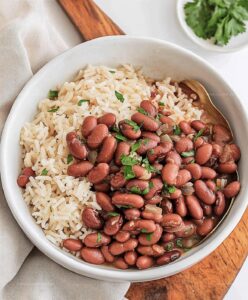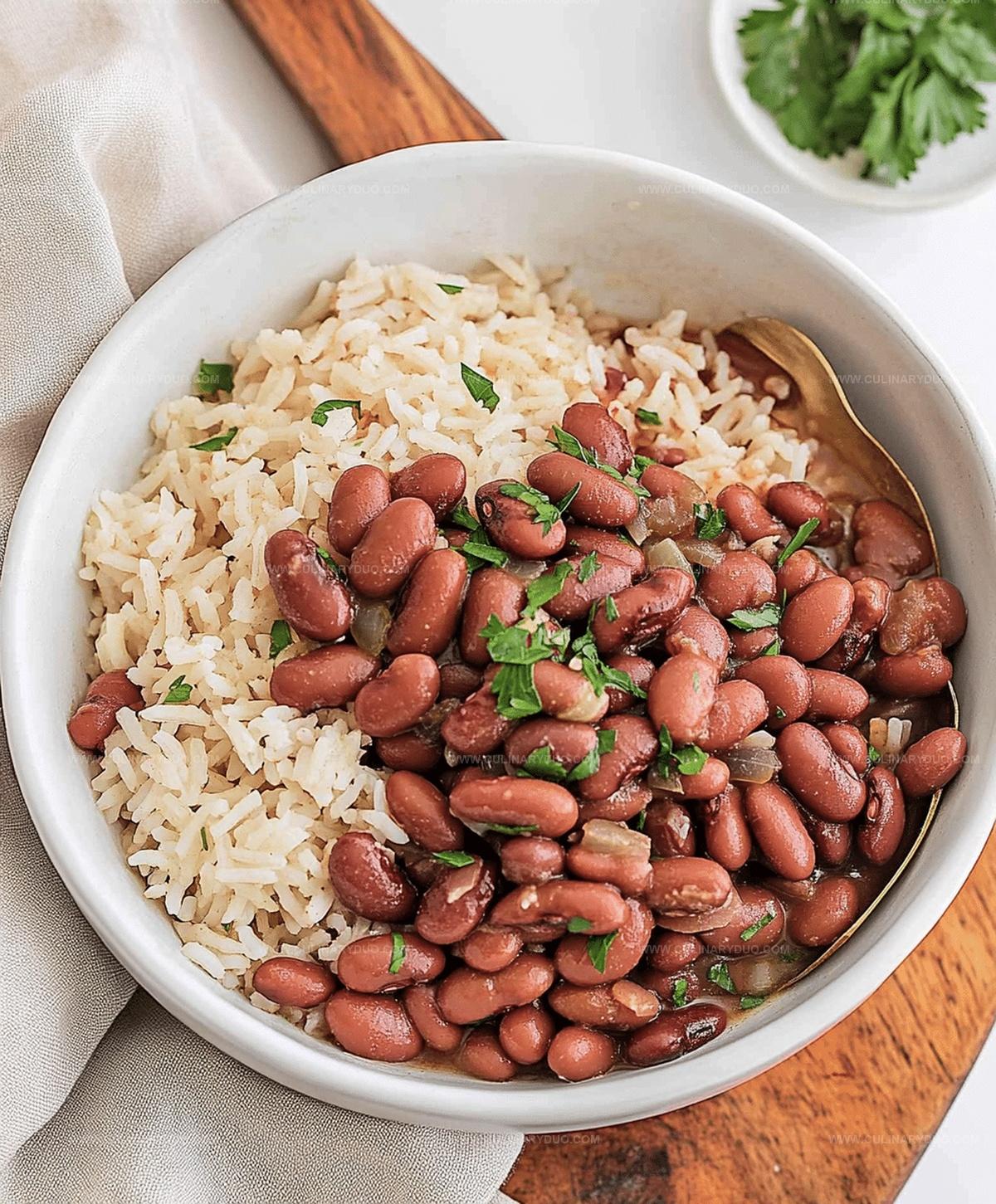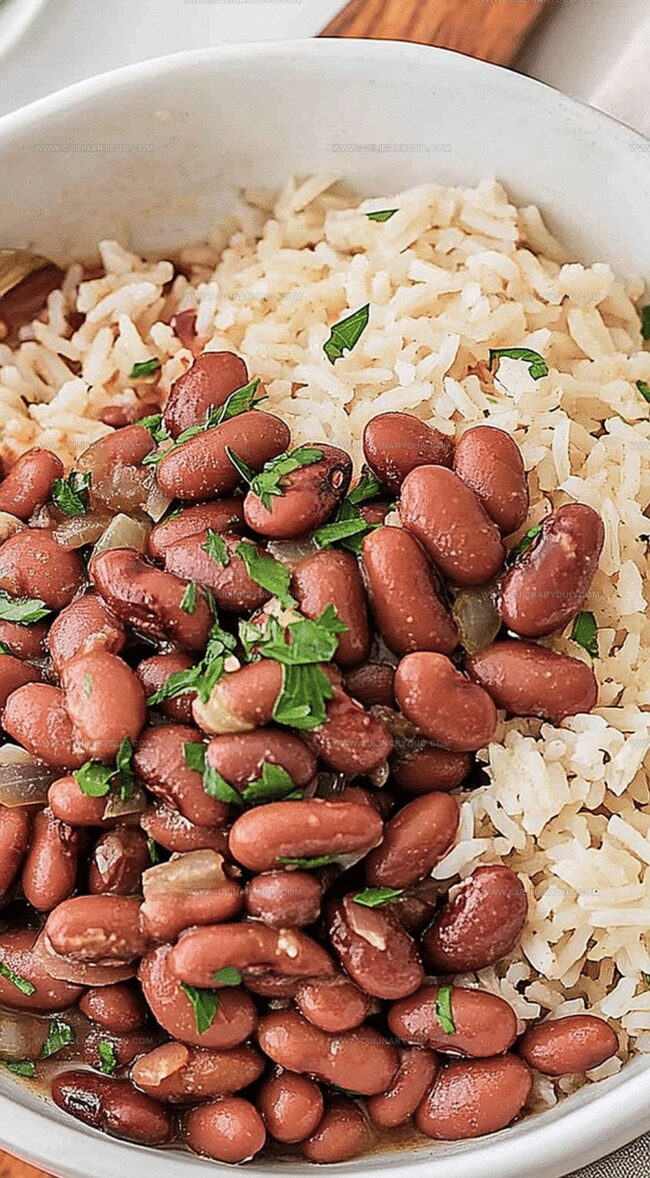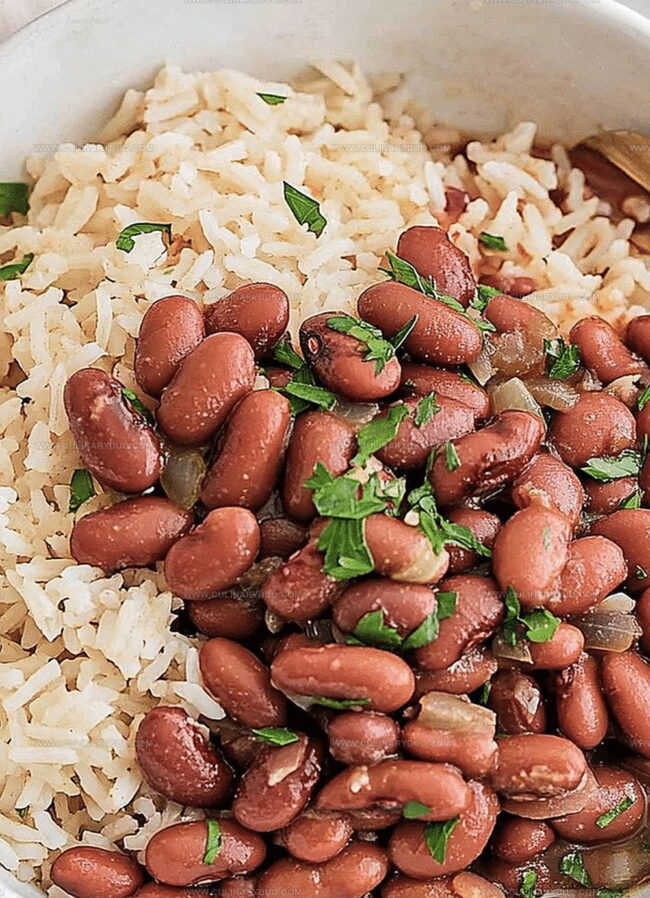Hearty Louisiana Red Beans And Rice Recipe: Homestyle Magic
Comfort food from the heart of the South, this louisiana red beans and rice recipe brings soul-warming flavors to your dinner table.
Generations of cooks have perfected this classic dish with tender, creamy beans and rich, smoky seasonings.
Authentic New Orleans cuisine shines through every delectable bite.
The combination of slow-simmered red beans and perfectly seasoned rice creates a hearty meal that speaks to tradition.
Spicy andouille sausage adds depth and excitement to this beloved southern staple.
Each forkful tells a story of culinary heritage and home-cooked love.
Louisiana Red Beans and Rice, Why It’s a Classic
Ingredient Checklist for Louisiana Beans and Rice
Main Ingredients:Aromatics and Vegetables:Herbs, Spices, and Seasonings:Cooking Liquids:Cooking Steps for Bold Red Beans and Rice
Step 1: Prepare Red Beans
Wash dried red beans thoroughly.
Cover beans with water and let them soak overnight in a large bowl.
In the morning, drain the beans and set them aside.
Step 2: Sauté Vegetable Base
Heat olive oil in a large Dutch oven or heavy pot over medium heat.
Add these vegetables and cook until soft and fragrant:Stir continuously for about 5 minutes until vegetables become translucent.
Step 3: Build Flavor Foundation
Toss in minced garlic and cook for 60 seconds.
Add smoked sausage and brown lightly, stirring occasionally to prevent sticking.
Step 4: Create Bean Stew
Pour in the soaked red beans along with these seasonings:Stir ingredients until well combined.
Step 5: Slow Cook Beans
Bring mixture to a rolling boil, then reduce heat to low.
Cover pot and simmer gently for 1.5-2 hours.
Stir occasionally and check bean tenderness.
Step 6: Achieve Creamy Texture
Remove bay leaves.
Use a wooden spoon to mash some beans against pot sides, creating a rich, creamy consistency.
Step 7: Serve And Garnish
Ladle hot bean mixture over fluffy white rice.
Top with chopped green onions or fresh parsley for added brightness.
Tips for Authentic Red Beans and Rice
Red Beans and Rice – Ways to Switch It Up
How to Serve Red Beans and Rice
Keeping Beans and Rice Fresh for Leftovers
FAQs
Red beans and rice originated in New Orleans as a budget-friendly, hearty meal typically prepared on Mondays using leftover Sunday ham bones, becoming a cultural staple in Creole cuisine.
While dried beans provide better texture and flavor, you can substitute with canned beans. Just reduce cooking time and adjust liquid accordingly, as canned beans are already cooked.
Andouille sausage is traditional and recommended, providing a smoky, spicy flavor that complements the beans perfectly. If unavailable, smoked kielbasa makes a good alternative.
Print
Bold Louisiana Red Beans And Rice Recipe
- Total Time: 10 hours 15 minutes
- Yield: 6 1x
Description
Hearty Louisiana red beans and rice blend Creole comfort with robust flavors, simmering with smoky andouille sausage and tender beans. Spicy and satisfying, this classic dish offers a delicious journey through Southern culinary traditions you’ll savor to the last bite.
Ingredients
Main Protein:
- 1 lb dried red beans
- 1 lb smoked sausage, sliced
Vegetables and Aromatics:
- 1 medium onion, diced
- 1 green bell pepper, diced
- 2 celery stalks, diced
- 3 garlic cloves, minced
Seasonings and Liquids:
- 2 bay leaves
- 1 teaspoon thyme
- 1 teaspoon smoked paprika
- 1/2 teaspoon cayenne pepper (optional)
- 6 cups water or chicken broth
- 2 tablespoons olive oil
- 4 cups cooked white rice
- Salt and pepper to taste
Instructions
- Immerse dried red beans in cool water overnight, allowing them to plump and soften. Drain thoroughly and prepare for cooking.
- Warm olive oil in a substantial pot over medium heat. Gently sauté the holy trinity of Creole cooking – onions, bell peppers, and celery – until they become translucent and fragrant, approximately 5 minutes.
- Introduce minced garlic and allow its aroma to bloom for 60 seconds. Incorporate smoked sausage, browning it to develop rich, deep flavors.
- Pour in red beans, liquid (water or broth), bay leaves, thyme, smoked paprika, cayenne pepper, salt, and black pepper. Mix ingredients thoroughly to distribute seasonings evenly.
- Elevate temperature until mixture reaches a robust boil, then reduce to a gentle simmer. Cover pot and allow beans to cook for 1.5-2 hours at low heat, stirring intermittently to prevent sticking.
- Extract bay leaves from the mixture. Crush a portion of beans against pot’s side using a wooden spoon, creating a luxuriously creamy consistency.
- Ladle the hearty bean mixture over steamed white rice. Optionally, sprinkle fresh green onions or parsley on top for added brightness and color.
Notes
- Soak beans thoroughly to reduce cooking time and improve digestibility, ensuring they are fully submerged in water overnight.
- Allow extra time for slow cooking, as low and slow develops deeper, richer flavors in traditional Louisiana-style red beans.
- Use smoked sausage like andouille for authentic taste, but consider vegetarian alternatives like plant-based sausage or extra vegetables for dietary variations.
- Mashing some beans creates a luxurious, creamy texture without adding cream, making the dish naturally thicker and more satisfying.
- Prep Time: 8 hours 15 minutes
- Cook Time: 2 hours
- Category: Lunch, Dinner
- Method: Simmering
- Cuisine: Creole
Nutrition
- Serving Size: 6
- Calories: 472 kcal
- Sugar: 3 g
- Sodium: 620 mg
- Fat: 19 g
- Saturated Fat: 5 g
- Unsaturated Fat: 13 g
- Trans Fat: 0 g
- Carbohydrates: 55 g
- Fiber: 10 g
- Protein: 27 g
- Cholesterol: 45 mg




Natalie Brooks
Co-Founder & Content Strategist
Expertise
Education
eCornell
Natalie brings the vibrant, plant-powered side to Culinary Duo. After earning her Plant-Based Nutrition Certificate from eCornell, she combined her love for fresh ingredients with a passion for storytelling, aiming to make healthy cooking simple and satisfying.
Her kitchen motto: good food doesn’t need a fancy label, it just needs fresh ideas and a little creativity. Outside of writing and recipe testing, Natalie’s happiest in her garden, exploring farmers’ markets, or mixing global flavors into new kitchen experiments.